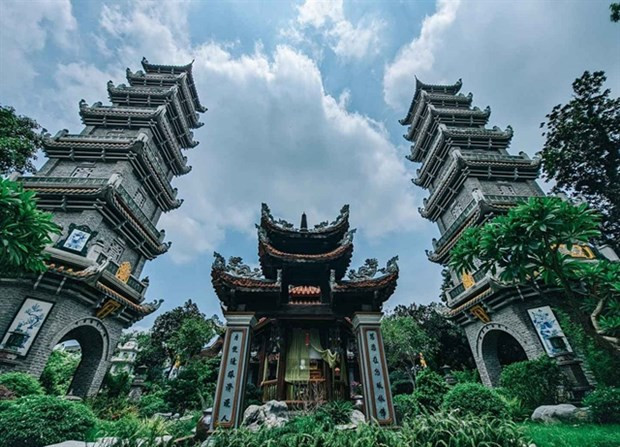While Hanoi is known for its sheer hustle and bustle, the capital city is also home to several beautiful and peaceful rural villages in southern neighbourhoods.
The Hanoi Department of Tourism has recently brought a group of tour agency managers and journalists to three villages as part of a special tour Con Duong Di San Nam Thang Long (Exploring the Heritage Road in South Thang Long, former name of Hanoi). The exciting new tour is expected to bring in tourists from home and abroad to stay longer in the city.
Hidden beauties
About 15km from the city centre, Ngau village in Tam Hiep commune of Thanh Tri district is home to Ngau Pagoda. It was built in 1130 and is believed to be the first pagoda where local people worshipped the Buddha and the Ngau Goddess.
However, it was destroyed and abandoned during the war before being rebuilt in 1995. The new pagoda remains true to the original architecture and shows high artistic value. The beauty of the pagoda lies in harmony with the rural landscape and surrounding environment.
Ngau village is also famed for its daisy-scented rice wine, which is said to have been first made around the 14th century. It was praised as one of the two best wines of the capital by illustrious Vietnamese Confucian scholar-statesman Nguyen Trai (1380-1442) in his Geographical Notes.
Ngau villagers still produce the flavoursome wine following their ancestors’ secret recipe.
According to Do Thi Kim Chi, a local brewer, to make good wine, it takes nearly a year to prepare the ingredients, and bury the wine in the garden to balance the yin and yang elements in the wine before serving. Its long-lasting and unique floral flavour has made it much loved at home, and even abroad. Brewers in the village have established the Cooperative of Ngau Wine Production and Trade Services to promote the ancient craft.
Nearly 10km from Ngau, people can visit Phuc Am Village, which specialises in making votive offerings. The products made here, including colourful paper clothing, horses, elephants, and figures of various kinds of deities, are usually burnt at funerals and other ceremonies.
In recent years, especially because of the pandemic, business has been negatively affected, but many households still retain the craft which is not only their main income but a tradition.
“Our village was previously known for weaving bamboo baskets. But our production declined rapidly due to the cheap plastic items, and the villagers began to switch to making votive offerings,” said a local resident, Nguyen Van Thanh.
Under his family members’ skilful hands, bamboo and paper are shaped into beautiful figures that serve traditional and religious rituals.
It takes much time and many steps for Thanh to complete a product. He has to build the bamboo frame of a figure and cover it with layers of colourful paper and glue, and then finish the outside details to make the product look soulful.
Cuu village, nearly 40km from Hanoi centre, is the last destination of the tour. Here, you can see dozens of old houses with Vietnamese and French architecture in the middle of a rustic and peaceful hamlet in Van Tu commune, Phu Xuyen district.
From 1920-45, dozens of villas were built with arched architecture, flowing roofs and ironwood. Small delicate details on these buildings include bas-reliefs of flowers, cranes and phoenixes.
The 500-year-old village has been a tailoring hub since the early 20th century, and was recently used as a location in a popular television series.
Many families still have sewing jobs here, showcasing their hard work and ingenuity.
“Cuu village has been well-known since Vietnam was a French colony. The sewing and embroidery skills of our villagers were trusted by the French and wealthy people throughout the country,” said villager Nguyen Thien Tu.
“Cash earned from tailoring changed the village. Many of the residents built beautiful villas, which made us known as the ‘village of the rich’.”
Despite the development of society, the villas were preserved by villagers who tried to keep the original architecture.
“We hope Cuu becomes an attractive tourist destination, attracting tourists to explore. With the help of the local authorities, community tourism will help us improve our lives and show the heritage here,” Tu said.
Plans needed
Phan Huy Cuong, head of the Planning Office at the Hanoi Department of Tourism, said that the inspection tour would provide a basis for forming more tours to the city’s southern outskirts in the near future.
He said he hoped that the new tour would enrich tourists’ experience, bringing a “new breeze” to the tourism business in the capital this year.
Duong Xuan Trang, director of Mai Viet Travel, said the tour would help attract inbound visitors, especially Europeans who would love Ngau Village with its beautiful pagoda and unique wine.
Meanwhile, Chairman of the Hanoi Travel Association Phung Quang Thang said: “Connecting inter-regional routes aims to diversify tourism products linking localities together, promoting tourism in the region. This route will help enhance the image of all three localities while helping promote services and develop infrastructure.”
“It will also lead to cultural exchange, and protect the environment and local ecosystems.”/.
VNS





